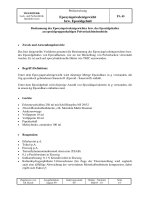Tài liệu PURCHASING DECISION pptx
Bạn đang xem bản rút gọn của tài liệu. Xem và tải ngay bản đầy đủ của tài liệu tại đây (513.74 KB, 46 trang )
1
Economic Decisions within the
Private Household
Hanoi, Vietnam
October 2006
Erich Kirchler
(economic decisions within the
private household)
Well-being
Money and tax (€)
Leadership, advertisement, consumer loyalty etc.
Group decision making (economic decisions within the
private household)
2
Economic decisions within
the private household
15 years of studies
on expenditures and
other economic
decisions within the
family
3
Decisions within private
households
• Normative (rational) model
Identifiable decision-maker(s)
Complete knowledge about all available alternatives
All the consequences are clear and evaluable
Evaluation on the basis of clear, stable goals
All consequences have known probabilities
Relevance of information can be evaluated, information can be collected
• Description (K. Weick)
Isolation of decisions
Multiple goals
Tiredness and simultanous solving of problems
4
Questions
• Who is/are the decision maker(s)?
• Which decisions can be taken?
• How do decisions proceed?
• How can decisions be analysed?
• Who has got influence and why?
• Are decisions isolated incidents?
• Which tactics do partners use?
5
Who are the decision makers?
Power structure
Patriachy
Matriarchy
Egoism principle
Equity
principle
Credit
principle
Love
principle
Egoism principle
high
low
H
a
r
m
o
n
y
in
t
he
r
e
la
t
io
n
s
h
ip
6
Interaction characteristics
(a) Interdependence vs independence of partners: People in relationships that can be
described using the love principle are dependent upon one another in their feelings, thoughts and actions and are
considerate on each other.
(b) Long-term vs short-term credit: In ad hoc groups or economic relationships, give and take
are directly linked (principle of reciprocity).When partners trust one another, they look for experiences that satisfy
both partners and distribute the available ressources according to needs. Balance is sought over the long term. If
the relationship progresses harmoniously, then in the end „book-keeping“ – to use a banking analogy – is no
longer necessary.
(c) Joint maximisation of profits vs cost-benefit analysis:Unhappy partners whose
relationship has become an economic relationship seek to exploit their opporunities for profit to the full.The more
harmonious the relationship, the less interest a partner has in concluding a trade with their partner.
(d) The distribution of rewards using rules of need vs equity rules.
(e) Abundance vs scarcity of ressources:
Whilst in economic relationships only certain types
of ressources are traded, which are mainly universalistic in terms of the concept of Foa and Foa (1974), in close
relationships also particularistic ressources besides universalistic ones are exchanged.
(f) Spontaneous altruism vs control of demands and obligations: Happy partners
do not seek to keep an account of demands and obligations. They act spontaneously in an partner-oriented manner.
(v. experiments of Clark, 1984).
7
Which decisions are there?
Purchase decisions
Money management
Savings decisions
Capital investment
management
Non economic
decisions
Economic
decisions
Decisions in private
housholds
8
Interest
Social
visibility
CollectivistIndividual
Unimportant Symbolic
Habitual
decisions
Spontanous
decisions
Autonomous
decisions
Syncratic
decisions
R
e
a
d
y
D
e
c
i
s
i
o
n
s
c
r
i
p
t
N
o
n
e
x
i
s
t
e
n
t
L
o
w
Fi
n
a
n
c
i
a
l
c
o
m
m
i
t
m
e
n
t
H
i
g
h
9
Interpersonal
conflict
Probability
conflict
Value conflict
Distribution
conflict
Agreement
Syncratic
decisions
10
How do decisions proceed?
Informationssuche
egoistische
Bewertung der
Alternativen
Harmonie
Machtrelation
Präferenzordung
Person A
Harmonie
Machtrelation
Produkttyp
Informationssuche
Harmonie
Machtrelation
Präferenzordung
Person B
Harmonie
Machtrelation
Produkttyp
Umwelt
(z. B. Marktgeschehen,
Referenzpersonen)
autonome
Entscheidung
autonome
Entscheidung
Vergleich der
Übereinstimmung
Wert-
konflikt
Sach-
konflikt
Verteilungs-
konflikt
Harmonie
Machtrelation
Konfliktlösungs-
versuche
intra-
individueller
Konflikt
Nutzens-
regelung
synkratische
Entscheidung
Meinungen
Konflikt
Bedürfnis
Set von
Alternativen
Bedürfnis
Set von
Alternativen
Spontan- oder
Gewohnheits-
entscheidung
Spontan- oder
Gewohnheits-
entscheidung
egoistische
Bewertung der
Alternativen
altruistische
Bewertung der
Alternativen
altruistische
Bewertung der
Alternativen
11
Inform. search
Egoistic
evaluation of
alternatives
Harmony
Power
Preferences
Person A
Inform. search
Harmony
Power
Preferences
Person B
Context
(e.g. market events,
reference people)
Need
alternatives
Need
alternatives
Spontansous or
habitual
decision
Egoistic
evaluation of
alternatives
Altruistic
evaluation of
alternatives
Altruistic
evaluation of
alternatives
Spontaneous or
habitual
decision
Comparison
Informationssuche
egoistis che
Bewertung de r
Alternativen
Harmonie
Machtrelation
Präferenzordung
Person A
Harmonie
Machtrelation
Produkttyp
Informationssuche
Harmonie
Machtrelation
Präferenzordung
Person B
Harmonie
Machtrelation
Produkttyp
Umwelt
(z. B. Marktgeschehen,
Referenzpersonen)
autonome
Entschei dung
autonome
Entschei dung
Vergleichder
Überei nstimmung
Wert-
konflikt
Sach-
konflikt
Vertei lungs-
konflikt
Harmonie
Machtrelation
Konfliktlösungs -
versuch e
intra-
individuelle r
Konflikt
Nutzens-
regelung
synkratis che
Entschei dung
Meinungen
Konflikt
Bedürfnis
Set von
Alternativen
Bedürfnis
Set von
Alternativen
Spontan-oder
Gewohnhe its-
entsche idung
Spontan-oder
Gewohnhe its-
entsche idung
egoistische
Bewertung de r
Alternativen
altruistische
Bewertung de r
Alternativen
altruistische
Bewertung de r
Alternativen
Set of Set of
Informationssuche
egoistis che
Bewertung de r
Alternativen
Harmonie
Machtrelation
Präferenzordung
Person A
Harmonie
Machtrelation
Produkttyp
Informationssuche
Harmonie
Machtrelation
Präferenzordung
Person B
Harmonie
Machtrelation
Produkttyp
Umwelt
(z. B. Marktgeschehen,
Referenzpersonen)
autonome
Entschei dung
autonome
Entschei dung
Vergleichder
Überei nstimmung
Wert-
konflikt
Sach-
konflikt
Vertei lungs-
konflikt
Harmonie
Machtrelation
Konfliktlösungs -
versuch e
intra-
individuelle r
Konflikt
Nutzens-
regelung
synkratis che
Entschei dung
Meinungen
Konflikt
Bedürfnis
Set von
Alternativen
Bedürfnis
Set von
Alternativen
Spontan-oder
Gewohnhe its-
entsche idung
Spontan-oder
Gewohnhe its-
entsche idung
egoistische
Bewertung de r
Alternativen
altruistische
Bewertung de r
Alternativen
altruistische
Bewertung de r
Alternativen
Autonomous
decision
Agreement
Conflict
Harmony
Power
Product type
Harmony
Power
Product type
Comparison
of opinions
Autonomous
decision
12
Value
Probability
Distribution
Harmony
Power
Resolution
of conflict
Intra-
individual
conflict
Syncratic
decision
Agreement
Conflict
Comparison
of opinions
Regulation
of benefit
Informationssuche
egoistische
Bewertung de r
Alternativen
Harmonie
Machtrelation
Präfer enzor dung
Person A
Harmonie
Machtrelation
Produkttyp
Informationssuche
Harmonie
Machtrelation
Präfer enzor dung
Person B
Harmonie
Machtrelation
Produkttyp
Umwelt
(z. B. Marktgeschehen,
Referenzpersonen)
autonome
Entschei dung
autonome
Entschei dung
Vergleich der
Überei nstimmung
Wert-
konflikt
Sach-
konflikt
Vertei lungs-
konflikt
Harmonie
Machtrelation
Konfliktlösungs -
versuch e
intra-
individuelle r
Konflikt
Nutzens-
regelung
synkratis che
Entschei dung
Meinungen
Konflikt
Bedürfnis
Set von
Alternativen
Bedürfnis
Set von
Alternativen
Spontan-oder
Gewohnhe its-
entsche idung
Spontan-oder
Gewohnhe its-
entsche idung
egoistische
Bewertung de r
Alternativen
altruistische
Bewertung de r
Alternativen
altruistische
Bewertung de r
Alternativen
T
h
e
e
n
d
13
14
How can decisions be analysed?
• Observation in the laboratory and in private settings:
• Ad hoc small groups: In close relationships, processes develop that are unique.
Typically small groups were mainly observed in the laboratory and were ad hoc
acquaintances who had only recently met. These volunteers were asked to
perform a task that was neither particularly interesting nor particularly
challenging. Because these participants had neither a shared past nor the
prospect of a shared future in front of them, there was no reason for them to
show particular commitment to the joint task and the interactions were at best an
ordered series of actions, whilst in close relationships complex patterns of
interaction can develop over a short period of time which can be difficult to
decipher for an external observer.
• Synthetic families are, compared to partners in close relationships, like a
"good-looking car with no engine" (Kemp, 1970, p. 30).
15
• Interview techniques
• Who is the informant? Davis (1970) reports that the perceived pattern of influence of
partners in discussions about purchasing a car or furniture is a near-perfect match if the
information provided by men and women is taken across the sample as a whole. At the
aggregated level, differences between individual couples' responses are balanced out;
whereas at the level of individual couples there are clear differences in male and female
perceptions.
• When partners are asked to recount their shared experiences, their accounts often differ
markedly. The differences are partly caused by the difficulty of recalling and
"reconstructing" mundane events, and partly because people distort their account to
bolster their own self-esteem.
• Kirchler (1989) summarized the results of 16 studies looking at influence patterns in
relationships, as reported by both partners, and found that in about 60% of cases overall
there was congruence in reports. In over a third of cases the reports differed.
• Partners in close relationships describe shared events differently and are also barely able to
imagine themselves in the position of their partner. Even happy partners lack „empathic
accuracy“. Increasing relationship quality is associated with increasing presumed similarity
between the behaviour of the partners and increasing „false consensus effect“.
16
You let
yourself go
Exactly!!
and
then he said that
he would never
leave me.
17
Correlation between self-perception and the partner perception (results of the
Italian study are shown in brackets; Kirchler, 1999; Kirchler and Berti, 1996)
Information about
tactics: man reports
on woman
Information about
tactics: woman
reports on man
Self-perception
by the man
Self-perception
by the woman
r=.54 (.58)
r=.69 (.67)
Perceived
congruence
r=.71 (.71)
Perceived
congruence
r=.57 (.60)
Congruence
r=.61
(.52)
Accuracy of
information
from woman
r=.60
(.55)
Accuracy of
information
from man
18
Sources of divergence
Different tendencies to provide socially desirable answers.
Strong emotions can "blind" participants to the feelings of their partner
and to details of social interactions.
Unclear remembrance due to relative unimportance of the everyday
events being reported.
Finally, it is known from narrative interviews and studies of "accounts of
one's own relationship" (Hinde, 1997) that partners construct different
images of their shared reality and "plug the gaps" in their own memory so
that the past appears consistent, meaningful and logical (Ross, 1989).
When complex information needs to be processed with little time
available, and when events have been perceived and dealt with without
much attention and are therefore recalled poorly, then interviewees will
often resort to stereotypes, prejudices or schematized images in the hope
that reality will in correspond to this to some degree (Hastie, 1982).
19
Sources
Everyday life at home is marked by a variety of mundane, routine events which are
rarely paid any attention. Because attention is directed elsewhere, the reliability of
memory of those events is called into question. Memory fades if events lie a long
time back in the past Saltfort and Roy (1981) compared data from
questionnaires with diary records and found that the diaries reported the purchase
of cheap, unimportant, non-fashionable products far more often than the
questionnaires. It is probable that in retrospect special events are recalled more
often than routine actions.
The mood influences the evaluation of events. Bower (1981) hypothesizes that
experiences which are congruent with one's feelings are remembered better than
those which are incongruent.
Everyday life is complex and is structured cognitively by relationship partners in
their own subjective manner. The private language of the partners is an indication
of the subjective organization of shared events. In a questionnaire, the possibilities
for subjective structuring of the experienced reality is severely limited.
20
Sources
Questionnaire responses are ultimately also dependent on the possible alternative
answers provided. This may sound banal – however, this does not simply mean that the
researcher is presenting his or her picture of reality through the order of the answers and
forcing those interviewed to answer within a defined framework. Schwarz and Scheuring
(1988) demonstrated impressively that the differentiation contained within the scale of
answers can also lead to completely different sets of results.
Schwarz and Scheuring (1988) asked about the frequency of sex with the partner and
frequency of masturbation, offering in each case a 6-point scale. In one test condition,
answers were differentiated using a high-frequency field, and in the other test condition a
low-frequency field was covered (see Table 4). After this a question was put asking
about the quality of the relationship, with an 11-point scale given. When high-frequency
alternative answers were offered, results were obtained which showed that around 77%
of those interviewed had sex with their partner at least once a week, and around 69%
reported a masturbation frequency of at least once a week. If the low-frequency
alternative answers were used, then the corresponding figure for sex with the partner fell
to around 39% and for frequency of masturbation to around 42%. Satisfaction with the
relationship was however at the same level under both test conditions.
21
Examples for high- and low-frequency alternative
answers (Schwarz and Scheuring, 1988, p. 489)
Questions:
How often do you have sex with your partner?
How often do you masturbate?
High frequency Low frequency
alternative answers alternative answers
___________________________________________________________
( ) several times a day ( ) several times a week
( ) once a day ( ) once a week
( ) 3 to 4 times per week ( ) once a fortnight
( ) twice a week ( ) once a month
( ) once a week ( ) less than once a month
( ) less than once a week ( ) never
22
Diaries
• Time-sampling diaries
• Events diaries
• Interval diaries
• Partner decisions diary
•Etc.
23
24
25
Instructions for completing the diary
Together with your partner, recall all the conversations you have had together today, and what topics were discussed in these
conversations. Try to remember the conversations accurately, and recall any differences of opinion between you and your
partner at the beginning, during, or at the end of the conversation. When you have decided together what it was you talked
about, and which matters you disagreed about – even if the difference of opinion was only slight – please fill in the diary on
your own. Begin by stating what you talked about. Then answer in detail about the conversations which represented a
difference of opinion between you and your partner.
Here is some information that you will find useful in completing the diary question sheet:
In general, a box is completed by filling in a number or symbol, and a circle by putting a cross in the relevant one.
On the first page of the diary, you will find some possible topics of conversation listed, as well as some statements about
feelings.
Question 1: This asks whether you and your partner have had a conversation. If you have not talked, go straight to question 3; if
you did talk to each other, please answer the questions in the order that they appear.
Question 2: Here you will find a series of conversation topics. The first three relate to economic matters. The first is about
expenditure on a product or service, whether expensive or inexpensive. Please specify which product or service it was. The
second relates to savings, either methods of saving or actual funds. Again, please state exactly what type of savings you
discussed. Your answer on the third topic is the place to mention all the money matters that do not come under the heading of
the first or the second topic. Question 2 then continues with other subject areas. At the end, there is space for subject areas that
do not feature in the list. These are for you to fill in yourself as required.
Record your feelings during the conversation by putting a "+" in the relevant box if you felt definitely good, and a "-" if you felt
definitely bad. If, exceptionally, you cannot decide whether your feelings were good or bad, or if you were entirely indifferent,
enter the symbol "0".
If you did not talk to your partner on a particular day, or did not disagree, then your entry will end at the bottom of the first
page. Otherwise, turn to the next page.
All the questions on the next page relate to a single conversation with your partner. Please answer all the questions. There are
lists associated with some of the questions. Wherever this is the case, please refer to the relevant list. Sometimes just one answer
is required; in other cases, you can give more than one answer.









